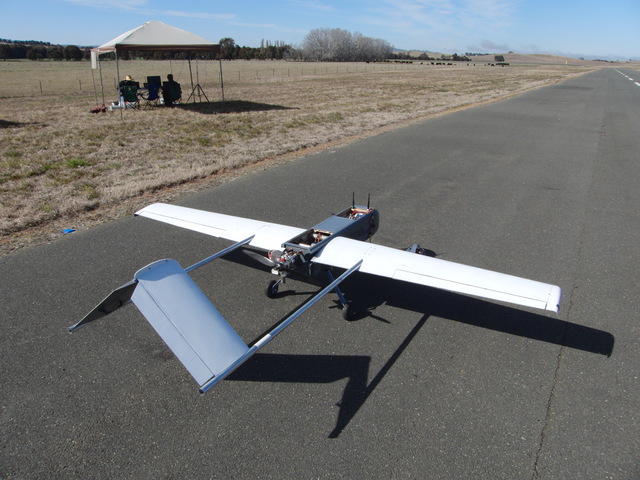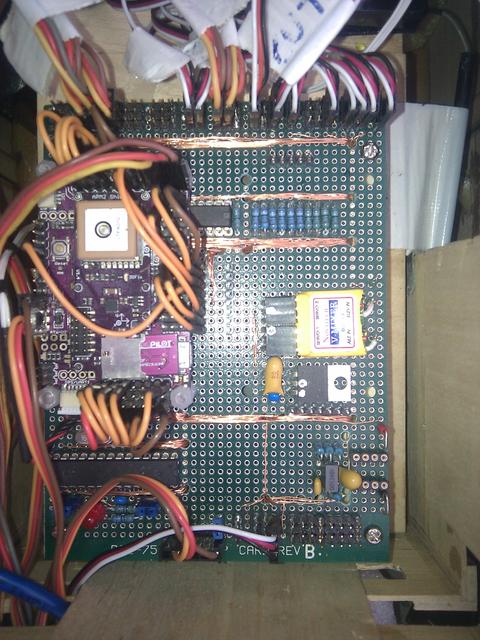
CanberraUAV
2012 UAV Challenge
This pages acts as an information resource for our our entry in the 2012 UAV Challenge, held in Kingaroy (Queensland, Australia) on the 1st to 4th October 2012. The full rules for the competition are available here [ http://www.canberrauav.com/sites/default/files/files/UAVChallengeRulesSearchAndRescue2011v1_4.pdf ]
It is hoped that other teams in future UAV Challenges can use this as a starting point for their own entries.
CanberraUAV is an open source organisation. We are more than happy to provide our source code, details of our setup, links to the manufacturers of our hardware and any flight data. If you can't find what you are looking for here, you are welcome to email us [ canberrauav@gmail.com ].
We'd also like to thank all of our sponsors for the 2012 Challenge:
Reports
As part of the competition were were required to submit several reports. There are available as shown:
Setup
The UAV
Our airframe was the "Mugin" (kindly donated by Cyber Technology). It is available from here [ http://www.fpvflying.com/products/Mugin-UAV-Platform.html ]. Note that we used an earlier version of the Mugin. Our airframe looks slightly different from the current for-sale version.
It is power by a Desert Aircraft DA-50 petrol engine [ http://www.desertaircraft.com/engines_detail.php?Page=DA-50-R ]. With a 3 litre fuel tank, it has a cruise time of 80 minutes.
The specifications of it are:

Onboard the Mugin, we had the following equipment:
The Pandaboard was directly connected to both radios, the APM, SSD and camera. It acted as the information hub for the UAV. Telemetry from the APM would be captured by the Pandaboard via the MAVProxy [ https://github.com/tridge/MAVProxy ] software. This would then be forwarded (along with thumbnails of the camera images) along both radio links to the ground station.
The Pandboard also ran a custom developed image analysis program [ https://github.com/tridge/cuav ] that could analyse the stream of images (7 frames/sec) in realtime.

Ground Station
Our ground station setup consisted of 3 laptops connected via a LAN. The "master" laptop was the only computer that could issue commands to the UAV.
The hardware of the ground station consisted of:
The radios were mounted on a 2m pointable antenna frame, itself mounted on top of a 2m trailer. The data from both radio links went directly (or via the LAN in the case of the Bullet) to the master GCS laptop. It would then forward the data to the other GCS laptops.
The laptops ran MAVProxy to view and interpret the telemetry
Results
CanberraUAV came first place in the 2012 UAV Outback Challenge. We were successfully in finding Joe autonomously. Unfortunately our bottle drop mechanism failed early on in the flight, meaning we weren't able to drop our bottle. A full debrief is available here [ http://diydrones.com/profiles/blogs/canberrauav-outback-challenge-2012-debrief ]
Our UAV survived the flight, minus damage to the bottle drop mechanism. The most likely reason for the failure of the bottle drop mechanism was the parachute coming loose during flight and getting tangled in the propeller. We were every lucky that the engine kept going in spite of this damage. A comprehensive analysis is available here [ http://www.diydrones.com/profiles/blogs/using-mavlink-to-debug-your-flight-canberrauav-style?xg_source=activity ]
The final scores for the competition were:
Flight Data
All of our flight data is available. It consists of the following datasets:
Photos and Reports
There are several photo albums of the competition and preparation. They are:
There are also several new stories about us:
The UAV Outback Challenge was an amazing event. We had an enormous amount of fun developing our UAV systems and we intend to enter the next UAV Outback Challenge!.
Copyright 2012 http://www.canberrauav.com/2012-uav-challenge-0